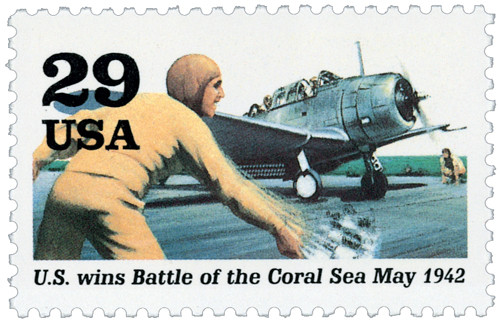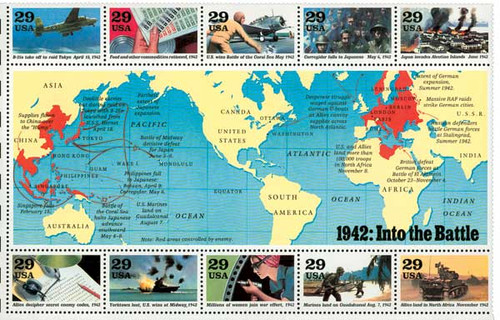
# 2697c FDC - 1992 29c World War II: US Wins Battle of the Coral Sea
US #2697c
1992 US Wins Battle of Coral Sea, May 1942
- Part of the second Souvenir Sheet issued to commemorate 50th anniversary of World War II
- Sheet contains 10 stamps and a world map.
Stamp Category: Commemorative
Set: 1942: Into the Battle, World War II
Value: 29¢ First Class Mail Rate
First Day of Issue: August 17, 1992
First Day City: Indianapolis, Indiana
Quantity Issued: 12,000,000 stamps
Printed by: Bureau of Engraving and Printing
Printing Method: offset/ intaglio
Format: Sheetlets of 10, arranged in two strips of 5 with a world map between. Offset printing plates of 8 sheetlets (2 across, 4 down). Intaglio printing sleeves of 16 sheetlets (2 across, 8 down)
Perforations: 11
Why the stamp was issued: This stamp is part of a sheetlet issued to commemorate the 50th anniversary of World War II. It was the second in a series of five that were issued over the course of five years.
About the stamp design: There were many topics the USPS wanted to cover when commemorating World War II, but those planning the series didn’t want to issue a large number of stamps. It was decided a sheetlet format would best highlight the main events of the war. In order for all the sheetlets to have a uniform design, the same artist, William Bond, and art director, Howard Paine, were assigned to the entire project.
The stamp highlighting the US victory at Coral Sea features a painting of a Douglas Dauntless dive bomber taking off from the deck of an aircraft carrier. This plane played a key role in the battle.
Special design details: Though the sheet is very similar to the 1991 issue, there are some small changes. In this sheet, the year 1942 was added to each individual stamp. The previous sheet only had the year on the map, so if the stamps were separated it would have been difficult to identify the year the stamp was commemorating. In addition, an explanation was added to the map which read, “Red areas controlled by enemy.”
First Day City: The First Day of Issue ceremony took place at the national convention of the Veterans of Foreign Wars of the United States, which took place in Indianapolis, Indiana.
About the World War II Series: As the 50th anniversary of World War II was approaching the US Postal Service wanted a series that would recognize the key events of the war and the important contributions America made to the Allied victory. Rather than issue a large number of stamps, the USPS decided to create five sheetlets, each commemorating one year of America’s involvement in the war. Each sheetlet had 10 different stamps arraigned in two horizontal strips of 5. In the center was a world map with Allied and neutral nations in yellow and Axis-controlled areas in red. Notes on the map highlighted key developments that occurred that year. The stamps each featured important events that took place during the year, as well.
History the stamp represents:
US Wins Battle of Coral Sea, May 1942
The Battle of Coral Sea saw the Imperial Japanese Navy face off against the US and Australian naval and air forces. It was the first battle in history where the opposing forces couldn’t see each other and didn’t fire on each other. Instead, planes from aircraft carriers attacked enemy ships.
At the time of the battle, Japan was intending to invade New Guinea and Tulagi in the Solomon Islands. On May 4, the Japanese were successful in invading Tulagi, though some of its ships were destroyed. Aware of the presence of American aircraft carriers, the Japanese advanced toward the Coral Sea. On May 8, both sides launched attacks on each other’s carriers. Aircraft and carriers on both sides were lost. Though the Japanese caused greater damage to the Allied fleet, they were forced to withdraw rather than invade New Guinea. This was the first time the Allies were able to stop a Japanese advance.
US #2697c
1992 US Wins Battle of Coral Sea, May 1942
- Part of the second Souvenir Sheet issued to commemorate 50th anniversary of World War II
- Sheet contains 10 stamps and a world map.
Stamp Category: Commemorative
Set: 1942: Into the Battle, World War II
Value: 29¢ First Class Mail Rate
First Day of Issue: August 17, 1992
First Day City: Indianapolis, Indiana
Quantity Issued: 12,000,000 stamps
Printed by: Bureau of Engraving and Printing
Printing Method: offset/ intaglio
Format: Sheetlets of 10, arranged in two strips of 5 with a world map between. Offset printing plates of 8 sheetlets (2 across, 4 down). Intaglio printing sleeves of 16 sheetlets (2 across, 8 down)
Perforations: 11
Why the stamp was issued: This stamp is part of a sheetlet issued to commemorate the 50th anniversary of World War II. It was the second in a series of five that were issued over the course of five years.
About the stamp design: There were many topics the USPS wanted to cover when commemorating World War II, but those planning the series didn’t want to issue a large number of stamps. It was decided a sheetlet format would best highlight the main events of the war. In order for all the sheetlets to have a uniform design, the same artist, William Bond, and art director, Howard Paine, were assigned to the entire project.
The stamp highlighting the US victory at Coral Sea features a painting of a Douglas Dauntless dive bomber taking off from the deck of an aircraft carrier. This plane played a key role in the battle.
Special design details: Though the sheet is very similar to the 1991 issue, there are some small changes. In this sheet, the year 1942 was added to each individual stamp. The previous sheet only had the year on the map, so if the stamps were separated it would have been difficult to identify the year the stamp was commemorating. In addition, an explanation was added to the map which read, “Red areas controlled by enemy.”
First Day City: The First Day of Issue ceremony took place at the national convention of the Veterans of Foreign Wars of the United States, which took place in Indianapolis, Indiana.
About the World War II Series: As the 50th anniversary of World War II was approaching the US Postal Service wanted a series that would recognize the key events of the war and the important contributions America made to the Allied victory. Rather than issue a large number of stamps, the USPS decided to create five sheetlets, each commemorating one year of America’s involvement in the war. Each sheetlet had 10 different stamps arraigned in two horizontal strips of 5. In the center was a world map with Allied and neutral nations in yellow and Axis-controlled areas in red. Notes on the map highlighted key developments that occurred that year. The stamps each featured important events that took place during the year, as well.
History the stamp represents:
US Wins Battle of Coral Sea, May 1942
The Battle of Coral Sea saw the Imperial Japanese Navy face off against the US and Australian naval and air forces. It was the first battle in history where the opposing forces couldn’t see each other and didn’t fire on each other. Instead, planes from aircraft carriers attacked enemy ships.
At the time of the battle, Japan was intending to invade New Guinea and Tulagi in the Solomon Islands. On May 4, the Japanese were successful in invading Tulagi, though some of its ships were destroyed. Aware of the presence of American aircraft carriers, the Japanese advanced toward the Coral Sea. On May 8, both sides launched attacks on each other’s carriers. Aircraft and carriers on both sides were lost. Though the Japanese caused greater damage to the Allied fleet, they were forced to withdraw rather than invade New Guinea. This was the first time the Allies were able to stop a Japanese advance.












